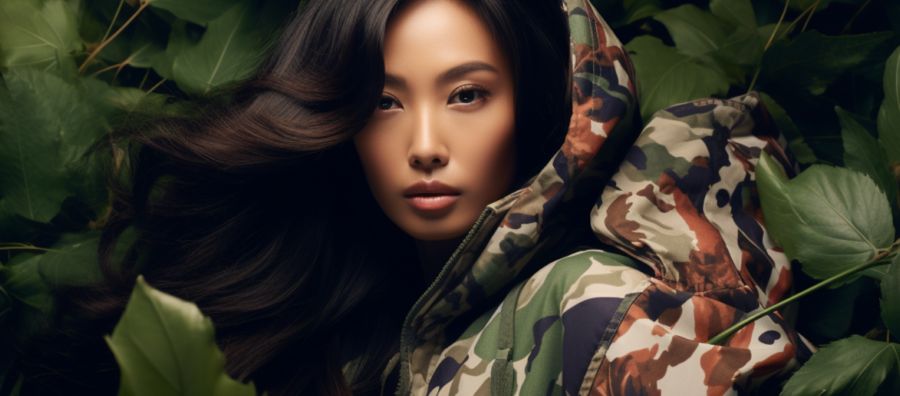Mimicry in Fashion: Camouflaging with the Environment

Blending In: A Surreptitious Strategy
As we traverse the treacherous landscape of modern fashion, it's not uncommon to find ourselves seeking refuge in the comforting folds of camouflage. No longer relegated to the ranks of military garb or the realm of hunters stalking their prey, camouflaging with the environment has infiltrated the world of fashion with a stealthy tenacity.But why does this phenomenon hold such sway over our sartorial sensibilities? Is it simply a matter of practicality, or is there a deeper psychological motivation at play? Enter the cunning world of mimicry in fashion, where we find ourselves adopting the chromatic quirks of our surroundings in order to blend in, stand out, or simply survive the relentless onslaught of shifting trends and merciless critics.
The Chameleonic Appeal of Camouflage
While many may dismiss the camouflaging tactics of the fashion world as mere frivolity, there's no denying the inherent allure of becoming one with one's environment. The ability to subtly adapt to the aesthetic landscape offers a certain sense of safety and belonging; an unspoken bond between wearer and world.Take, for instance, the rise of so-called "urban camouflage" in recent years. This curious blend of muted grays, blacks, and browns may not immediately scream "fashion statement," but it serves as a form of visual armor, allowing urban dwellers to navigate the concrete jungle without drawing undue attention to themselves. It's a sly nod to the eternal struggle between blending in and standing out - a delicate dance that we all must engage in to some extent.
Camouflage as Artful Subversion
Of course, the use of camouflage in fashion isn't always intended to be quite so subtle. In fact, some designers have taken the concept and run with it, creating bold and daring ensembles that gleefully subvert expectations.Consider the work of the inimitable Rei Kawakubo, whose avant-garde label Comme des Garçons has long been synonymous with boundary-pushing design. Kawakubo's creations often incorporate elements of camouflage, but rather than simply blending in, they demand to be seen. The result is a curious juxtaposition of the hidden and the exposed, the covert and the overt.
Or take the case of the late, great Alexander McQueen, who once sent models down the runway in dresses fashioned from what appeared to be military-grade netting. The message was clear: even in the realm of high fashion, where artifice and illusion reign supreme, there's no escaping the pervasive influence of camouflage.
Practical Tips for Camouflaging with Panache
So, how can one incorporate the art of mimicry into one's own wardrobe without succumbing to the pitfalls of cliché or kitsch? Here are a few practical tips for camouflaging with panache:- Embrace subtlety: When it comes to camouflage, less is often more. Instead of opting for head-to-toe woodland print, consider incorporating just a touch of camouflage in the form of a scarf, hat, or pair of shoes. A little goes a long way in creating a stylishly understated look.
- Think outside the box: Camouflage doesn't have to be limited to the traditional greens and browns of military garb. Experiment with unexpected color combinations or abstract patterns to create a more modern and unique take on the trend.
- Don't forget texture: The true secret to successful camouflage lies not just in color, but also in texture. Whether it's the rough surface of a stone wall or the smooth sheen of a city sidewalk, consider how the interplay of materials and patterns can help you blend in - or stand out - in your environment.
- Know your context: Finally, be mindful of the context in which you're wearing your camouflage. What may work at an outdoor music festival might not be quite as appropriate for a formal event or office setting. When in doubt, err on the side of subtlety and discretion.
Camouflage as a Reflection of our Zeitgeist
Ultimately, the enduring appeal of camouflage in fashion speaks to a deeper, more universal desire to adapt, assimilate, and occasionally subvert the world around us. In an age of constant flux and uncertainty, the ability to blend in - or stand out - on our own terms is a powerful and alluring concept.So, whether you're seeking solace in the anonymity of urban camouflage or boldly defying convention with avant-garde artistry, embracing mimicry in fashion can be a fascinating and rewarding journey. And as you navigate the ever-shifting landscape of style, remember: sometimes, the best way to make a statement is by blending in.
Article kindly provided by foreverinfashion.org
Latest Articles
- Style That Works With Your Body, Not Against It
- Fashion Tourism on Wheels: Curated Shopping Routes Led by Chauffeur Guides
- The Charm of Certainty in a World of Indecision
- Can an Everyday T-Shirt Be Turned into a Modern Heirloom?
- Color, Ceremony, and the Psychology of Celebration
- Styling Graphic T-Shirts for Different Body Types
- Getting Kids to Wear Their Hats Without a Bribe or a Meltdown
- Mastering the Art of Being the Unnoticed Photographer
- Quiet Sportswear Moves Loudly
- Fashion's Most Misunderstood Color Is Brown
- Weight Matters When Cotton Gets Real
- SKU's Out for Summer: Why Your Warehouse Is Melting Down
- Ink as Accessory - How Tattoos Are Replacing Jewelry in Modern Style
- Decoding the Y2K Aesthetic with Style and Sanity
- Accessories
- Jewellery
- Footwear
- Skirts and Dresses
- Shirts and Blouses
- Beauty and Makeup
- Fashion Photography
- Sustainable Fashion
- Street Style
- Fashion History
- Fashion Business
- Fashion Styling
- Fashion Events
- Plus-Size Fashion
- Men's Fashion
- Women's Fashion
- Fashion Blogging
- Fashion Trends
- Fashion Retailers
- Fashion Tips and Advice
- Fashion Business Startups
- Fashion Around the World
- Lingerie
- Sportswear
- Weddings

